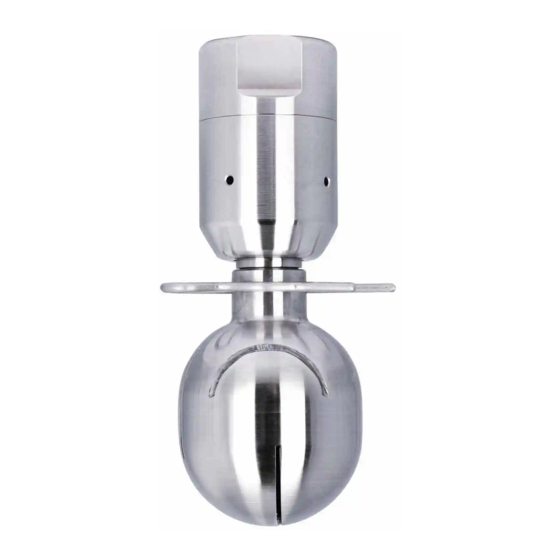
Summarization of Contents
General Information
Information about this document
Provides information about the operating instructions as part of user information.
Binding Character of These Operating Instructions
Emphasizes the manufacturer's instructions and the importance of reading them for safety.
Validity of the Instruction manual
States the manual is valid for ATEX marked cleaners and for use in potentially explosive atmospheres.
Manufacturer address
Lists the manufacturer's name and address.
Contact
Provides contact details including telephone, fax, and email for the manufacturer.
Marking
Explains the labeling on the rotating body of the cleaner, including type code and ATEX identification.
Safety
Intended use
Defines the cleaner's intended purpose for cleaning tanks and vessels at any angle.
Requirements for operation
Outlines prerequisites for safe operation: transport, storage, installation, and assembly.
Improper operating conditions
Lists conditions under which operating the cleaner is not permitted for safety.
Safety notes
Provides general safety precautions, including handling cleaning fluid and avoiding operation outside the object.
Safety notes
Continues with safety notes, including avoiding gas/vapour, pressure filling, and handling malfunctions.
Operating Conditions
Details requirements for effective operation, including pressure, flow rate, and temperature.
Temperature
Explains temperature classes and lists maximum surface temperatures for different classes.
Pressure
Specifies operating pressure ranges for different cleaner models.
Flow rate
Provides flow rate data for various cleaner models at different working pressures.
Flow rate
Continues to list flow rates for different cleaner models and connections.
Flow rate
Lists flow rates for Torus and Chemitorus models.
Declaration of Conformity
Declaration of Conformity
Lists various GEA cleaner models and their ATEX conformity details.
Cleaning
The cleaning of the tanks in explosive atmospheres
Explains how cleaning processes can generate electrostatic charges and form explosive atmospheres.
Basics
Details the three basic conditions for explosions: flammable gas/dust, ignition sources, and acid.
Guidelines
Lists manufacturer and operator responsibilities regarding ATEX directives for explosive atmospheres.
Selection of the cleaning parameters according to TRGS 727:2016
Provides guidance on selecting cleaning parameters to avoid explosion risks, focusing on liquid conductivity and pressure.
Preventing further ignition sources
Putting cleaner in the tank - mechanically generated sparks
Discusses risks of sparks from mechanical contact during cleaner insertion and how to avoid them.
Manhole cover
Specifies requirements for manhole covers when placing a cleaner in explosive areas.
Electric functions
States that electrical components must have ATEX approval and require correct connection.
Grounding - electrical load
Emphasizes the importance of grounding tanks and cleaners for electrical safety.
Filling the tanks
Notes that the container outlet must be open, not a filling process.
Inerting
Details the use of inert gas for tanks with explosive atmospheres to prevent mist formation.
Foreign material in the fluids.
Warns about foreign bodies exiting the nozzle and the need for permissible media.
Petroleum vehicles
Refers to the Ordinance on Flammable Liquids for hazardous areas.
Authorized personnel / OEM replacement parts
States that only authorized personnel and OEM parts should be used for servicing.
Maintenance
Recommends regular checks for damage and function, with visual inspection at each process.
Maintenance
Specifies mandatory maintenance intervals for ATEX cleaners and logging requirements.
Additional information on cleaner selection
Possibilities of ATEX classification
Explains ATEX grouping based on ignition hazard likelihood and restrictions on operation.
Cleaner with its own potential ignition source
Discusses ignition protection measures and classification for cleaners with potential ignition sources.
Additional restrictions on usable substances
Mentions potential restrictions on detergents and the need to observe manufacturer declarations.
Instructions for the operation of the cleaner
Covers temperature limiters for switching off the system and permissible temperatures.
Explosion groups
Explains gas classification based on ignitability and lists typical gases for groups IIA, IIB, IIC.
Substance classification
Details how substance classification depends on temperature classes and explosion groups for cleaner selection.
Further information sources
Further information sources
Lists various documents and regulations related to explosion protection when cleaning containers.
Appendix
Lists
Introduces the appendix section containing lists.
Abbreviations and terms
Provides definitions for abbreviations and technical terms used in the document.
Abbreviations and terms
Continues providing definitions for abbreviations and technical terms.












Need help?
Do you have a question about the Turbo SSB 125 and is the answer not in the manual?
Questions and answers